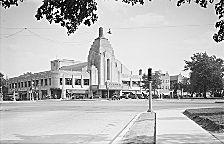| Entries |
| M |
|
Movie Palaces
|

|
B&K made the movie palace a fundamental part of city life by carefully exploiting five nonfilmic factors. First, B&K located near fans who had just moved to what were then outlying districts. New mass transit made access simple. Only after these outlying theaters prospered did B&K build downtown.
Second, B&K fully exploited movie palace architecture. Chicagoans of the 1920s heralded B&K movie palaces as the most magnificent in the world. Eight-story vertical signs blazed day and night. Lobbies held as many people as the auditorium, in spaces gilded in gold and awash with mirrors. Sweeping promenades were lit by opulent chandeliers; auditoria were fashioned from models based on exotica from Spain, Italy, and France.
Third, B&K treated all patrons like royalty with obedient corps of ushers, uniformed in red with white gloves and yellow epaulets, maintaining quiet decorum as they guided patrons to their seats. Free child care, and galleries lined with paintings and sculpture, drew additional patrons.
Fourth, B&K always offered a live stage show in addition to movies. B&K so carefully nurtured local talent that, by the middle 1920s, it had become more famous for its impressive stage attractions, orchestras, and organists than for the movies. Shows celebrated fads and heroes, from Lindbergh to the Charleston to “Jazz and Opera” week.
Fifth, when B&K's Central Park opened, it represented the first mechanically air-cooled theater in the world. Drawing on the experience of Chicago's meat packing industry with cooling, Barney Balaban convinced the Kroeschell Bros. Ice Machine Company to cool movie house patrons and, in 1921 with the building of the Tivoli and Chicago, to dehumidify them as well. B&K constantly hung icicles from newspaper advertisements; Chicago's Health Commissioner proclaimed their air purer than that of Pike's Peak; women in the final trimester of pregnancy were admitted free.
These five factors were widely copied and proved so influential that to understand how B&K accomplished this movie palace revolution is to understand how going to the movies rose to dominate mass entertainment through the middle of the twentieth century.
The Encyclopedia of Chicago © 2004 The Newberry Library. All Rights Reserved. Portions are copyrighted by other institutions and individuals. Additional information on copyright and permissions.